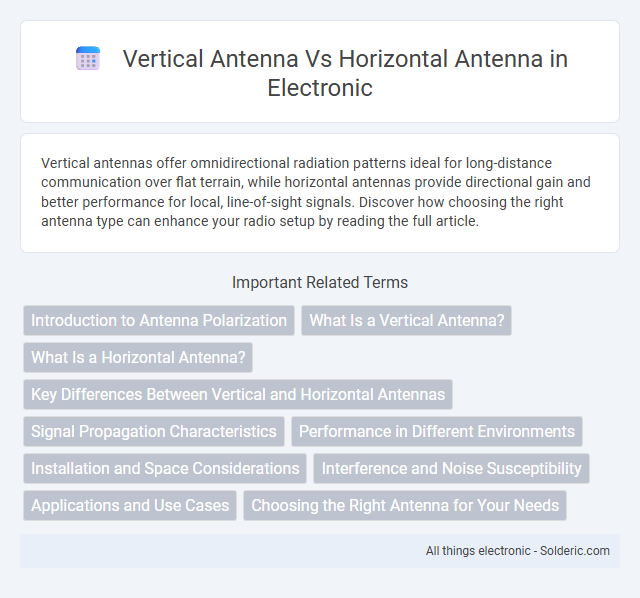Vertical antennas offer omnidirectional radiation patterns ideal for long-distance communication over flat terrain, while horizontal antennas provide directional gain and better performance for local, line-of-sight signals. Discover how choosing the right antenna type can enhance your radio setup by reading the full article.
Comparison Table
| Feature | Vertical Antenna | Horizontal Antenna |
|---|---|---|
| Polarization | Vertical | Horizontal |
| Radiation Pattern | Omnidirectional (horizontal plane) | Directional or Omnidirectional (depends on type) |
| Ground Requirements | Needs good ground plane or radials | No ground plane needed |
| Size | Typically more compact and vertical | Can be long and horizontal |
| Typical Use | Mobile, base stations, low-angle radiation | DXing, beamforming, high-angle radiation |
| Installation | Easier in limited space | Requires supports and more space |
| Signal Strength | Better for local, ground wave propagation | Better for long-distance, skywave communication |
Introduction to Antenna Polarization
Antenna polarization refers to the orientation of the electric field of the radiated waves, significantly affecting signal propagation and reception. Vertical antennas emit vertically polarized waves, which are ideal for ground-wave and urban communications due to their ability to reduce signal degradation from obstacles. Horizontal antennas produce horizontally polarized waves, offering superior performance for long-distance skywave propagation and minimizing interference in certain environments, helping optimize Your communication setup based on operational needs.
What Is a Vertical Antenna?
A vertical antenna is a type of radio antenna with its elements oriented perpendicular to the Earth's surface, typically used for omnidirectional signal transmission. Its design allows it to radiate signals uniformly in all horizontal directions, making it ideal for broad coverage and longer distance communication. Understanding the vertical antenna's performance characteristics can help you optimize your radio setup for better signal reach and clarity.
What Is a Horizontal Antenna?
A horizontal antenna is a type of radio antenna installed parallel to the Earth's surface, typically used for long-distance communication due to its favorable radiation pattern and lower angle of radiation. It is commonly employed in HF (high frequency) bands, offering improved signal strength for distant stations by directing signals horizontally. Your choice of antenna impacts transmission and reception quality, with horizontal antennas excelling in reducing noise and enhancing signal clarity in many radio applications.
Key Differences Between Vertical and Horizontal Antennas
Vertical antennas radiate signals omnidirectionally and are typically used for ground wave propagation, making them ideal for local communications and low-angle radiation for long-distance DX contacts. Horizontal antennas, such as dipoles, exhibit directional characteristics with higher radiation at certain angles, which enhances skywave propagation and is preferred for long-range HF communications. The primary differences lie in their radiation patterns, polarization, and ground interaction, influencing signal strength and reception quality based on the intended application and frequency band.
Signal Propagation Characteristics
Vertical antennas exhibit omnidirectional radiation patterns, providing low-angle signal propagation ideal for long-distance communication, especially over flat terrain and water surfaces. Horizontal antennas produce directional radiation patterns with higher angle signals, enhancing local area coverage and reducing interference but limiting range. Understanding these signal propagation characteristics helps you optimize antenna choice based on your communication needs and geographic conditions.
Performance in Different Environments
Vertical antennas excel in environments with limited horizontal space and perform well over highly conductive ground, making them ideal for urban or coastal areas. Horizontal antennas typically offer better performance in open, rural environments with minimal obstructions, providing improved signal gain and lower noise levels. Terrain conductivity and obstructions significantly influence antenna choice, with vertical antennas favoring low-angle radiation for long-distance communication and horizontal antennas supporting enhanced directivity and reduced interference.
Installation and Space Considerations
Vertical antennas require less horizontal space and are easier to install in confined areas, making them ideal for limited real estate or rooftop setups. Horizontal antennas often need more clearance and support structures due to their longer, spread-out elements, which can complicate installation in tight environments. Your choice depends on available space and installation complexity, with vertical antennas offering more flexibility for compact installations.
Interference and Noise Susceptibility
Vertical antennas generally exhibit lower susceptibility to man-made noise and interference because their omnidirectional radiation pattern reduces the impact of nearby electrical sources. Horizontal antennas often pick up more noise due to their broader reception pattern and sensitivity to vertically polarized interference from power lines and electronic devices. The choice between vertical and horizontal antennas influences noise levels based on the specific electromagnetic environment and the antenna's polarization relative to interference sources.
Applications and Use Cases
Vertical antennas excel in ground wave propagation, making them ideal for mobile communication, AM broadcasting, and maritime operations where omnidirectional coverage is essential. Horizontal antennas, with their higher gain at lower radiation angles, are preferred for long-distance skywave communication such as HF amateur radio and shortwave broadcasting. The choice between vertical and horizontal antennas depends on frequency band, propagation mode, and specific use cases like point-to-point links or broad area coverage.
Choosing the Right Antenna for Your Needs
Vertical antennas offer omnidirectional coverage and are ideal for limited space and NVIS communication, while horizontal antennas provide better noise reduction and enhanced long-distance performance with higher gain in specific directions. Your choice depends on factors like available space, desired coverage pattern, and communication range requirements. Understanding these characteristics helps optimize your antenna setup for efficient and reliable signal transmission.
vertical antenna vs horizontal antenna Infographic

 solderic.com
solderic.com